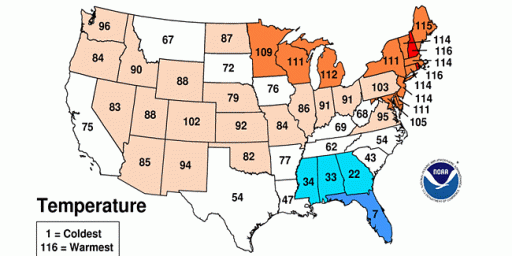130 Degrees in the Shade
Despite the mythology of soldiers “carrying 40 pounds of body armor in 130-degree temperatures” during their tours in Iraq, David Sessions explains, “the highest temperature ever recorded in Asia is 124 degrees—in Dhahran, Saudi Arabia.” Further, since there’s little humidity in the desert, “the heat index won’t be much higher than the actual temperature.”
Veterans of the Vietnam war also bandy about the 130-degree figure but, since Vietnam is in Asia, and it’s never been above 124 degrees there, it can’t be right. (Although, to be fair, it’s humid in the tropics, so the heat index might actually reach that mark.)
Maybe soldiers just like to bitch about how hot it is? Almost certainly. But there’s also a scientific explanation:
Soldiers and travelers often measure the temperature with personal thermometers, which tend to give inaccurate readings. Command posts sometimes place thermometers on their outside walls or other locations within their encampments, but these thermometers are also cheap and unscientific; one solider described them as the kind of thing you’d pick up from Wal-Mart or see in someone’s garden.
But even a perfectly functioning thermometer, if placed on a solid surface, is likely to deliver higher readings than one set up in an open, breezy area. In general, a solid object absorbs more heat than an equivalent volume of air and can rise to a higher temperature given the same amount of sunlight. An instrument placed on sand or concrete will absorb heat from that surface—obscuring (and inflating) the actual air temperature. So, depending on where it’s sitting, a surface thermometer can be off by more than 10 degrees. That’s why professional meteorologists prefer to measure the temperature in a ventilated location, and never set up their instruments on heat-conducting surfaces like sand, concrete, or asphalt.
Indeed, my car has a thermometer which displays external temperatures and I’ve frequently recorded 100-degree plus temperatures this summer, even though we’ve only barely crossed that mark here in the official statistics. The asphalt, though, apparently gets there more often.
UPDATE: Several commenters point out, quite correctly, that our soldiers in Iraq are quite frequently working on sand and asphalt and that, therefore, the fact that the official air temperature in some breezy location is of small comfort.
John Burgess adds another wrinkle:
Governments have laws or regulations that prohibit laborers from working when the outside temperature exceeds a certain point. (See Standing Up for Laborers in the Saudi Summer)
If the Weather Bureau says it’s above the set point, then millions of dollars of work isn’t getting done. The higher the temperature rises above the limit, the harder it is for the Weather Bureau to dissimulate. But it’s amazing how temperatures only rarely rise above the legal limit.
Interesting. While I”m well aware that government statistics are often skewed for a variety of reasons, especially in the developing world, it had never occurred to me that they’d lie about something as innocuous as temperature data.




Well, we know Tony Snow thinks that it is too hot for the government of Iraq to be expected to work. Course our guys go right on dying while they are on vacation…
In fairness, it must be noted that a soldier in full body armor and kit isn’t “an open, breezy area.”
Regards, C
Back in the Air Force (1982-85), working on jets at George Air Force Base in the California desert, we recorded air temps of over 140 on the pads near the aircraft, and 160 or more with the engines running. 110 in the shade means 140 or higher in the sun, and often over 150 on dark surfaces.
Well, the funny thing is, very little of a soldier’s work occurs in nice grassy areas with lots of shade and open to breezes. Quite a bit of the work happens in the open sun, on hard packed or asphalt roads while hugging the scorching hot walls of a building. Funny thing is all the earthen buildings with thick walls are designed to collect heat during the day and radiate it during the cooler night. Bad thing is when they are collecting the solar energy they are like walking next to an oven. Oh and not to worry that your hunkered down in a ravine with air as still as death, there is a 20 knot wind blowing at 10 m where the “official” wind is measured.
It makes sense to measure wx parameters in a consistent way that avoids local variances for global monitoring but it is ignorant to think that those “official” measurements are the be all end all to describe the local conditions experienced by those on the ground in any particular location.
James
Where to start? There is a problem with using the official climate temperatures that you seem to be referring to.
http://en.wikipedia.org/wiki/Temperature_extreme
First the official temperatures in many countries are taken from a very small numbers of recording devices. Take Kuwait for instance. The temperatures in Kuwait city or Camp Doha that is located along the coast was often far cooler than areas located in the center of the country. They didn’t have official weather stations out there to take temperatures.
Second as some have already stated, soldiers don’t work in temperatures zones that constitutes official temperatures zones. For example they don’t work in the shade four feet above the ground away from asphalt and sand. Often they are walking asphalt streets or are in metal armor vehicles, most of the time in direct sunlight. They lay on the ground at times.
I could go on and on but I think it is clear that the myth you claim to have busted is not busted.
One more comment, a soldier carries much more then his body armor.
James, if you do not think it gets that hot, spend some of the money you get for educating yourself to the degree that you have and travel to Iraq. You could write a paper on it when you return. Maybe get another degee.
Soldiers (like Marines, Sailors and Airmen) like to bitch because they like to bitch. Heat, cold, food it doesn’t matter they’ll bitch about it.
Another problem with assessing the temperatures is that the official meteorological groups in the Persian Gulf region (including Iraq) are government entities.
Governments have laws or regulations that prohibit laborers from working when the outside temperature exceeds a certain point. (See Standing Up for Laborers in the Saudi Summer)
If the Weather Bureau says it’s above the set point, then millions of dollars of work isn’t getting done. The higher the temperature rises above the limit, the harder it is for the Weather Bureau to dissimulate. But it’s amazing how temperatures only rarely rise above the legal limit.
I know many people, of many different professions, who’ve recorded temperatures approaching 150F in a variety of locations and circumstances in Saudi Arabia. Some were doing readings on flight lines, some at oil rigs, some standing out in the middle of the Empty Quarter just to measure the temperature.
130F is definitely surpassed, annually.
As noted in comments above, several points:
body armor is only a part of deployed soldier’s burden;
&
airy, open areas tend to not be where you find live soldiers living/working.
My personal thermometer, dogtag-sized, attached to the zipper-pull of my Franklin-Covey planner, and originally-purchased from (now defunct) Appalachian Outfitters of Vienna, Va registered 132 degrees Fahrenheit on at least one occasion I recall at TAA Hound, Iraq.
This effect is part of the Global Warming nonsense. The old line temp sensors in use for years in the little wooded ventilated boxes set out around the ocuntry are now located next to buildings, on asphalt, next to air conditioning compressors and outflows…all of which skew the entire temp grid. There are several sites with pics of these temp sensors now surrounded by man made stuff where they used to be out in a field especially set up to avoid the man made heat island affect.
I suppose that’s no worse than any other reason to go to ar Ruba’ al Khali. But it never seems like anyone has a good reason to go there, outside of books and movies.
I do recall in 1953, on the way to Korea -going through the Suez Canal when a thermometer in front of the cool, outside, forced air vent in our boileroom read 122 degrees. Behind the boiler was near unlivable – even for a few short minutes as hot air filled and seared your lungs. The metal rails down there would burn an ungloved hand. We survived -though I was many years younger then. The upside was that officers conducting inspections -straight from their air conditioned quarters would turn and run as soon as they felt the heat -We always passed those uninspected inspections.